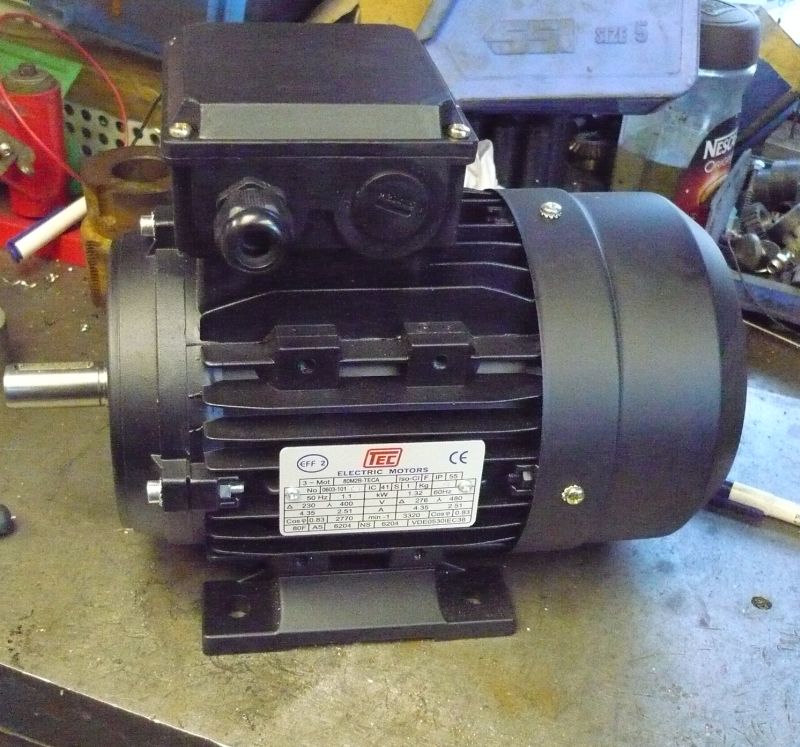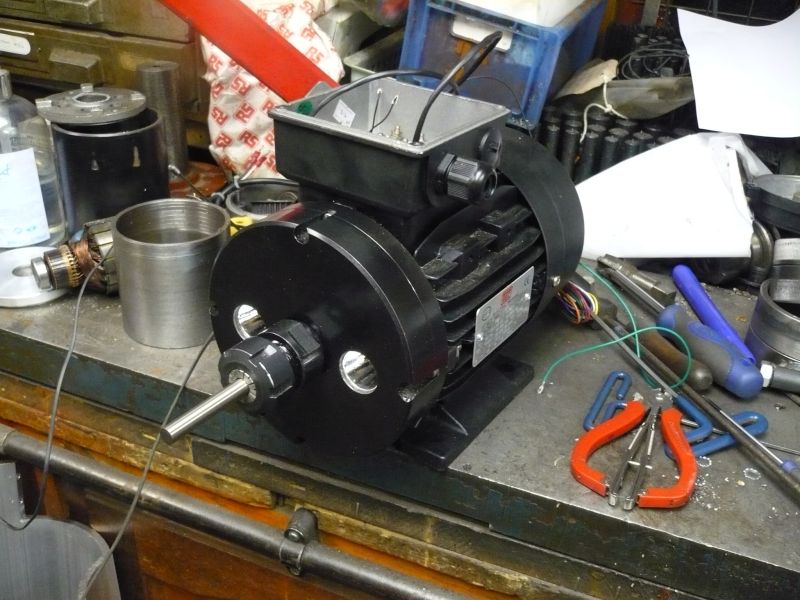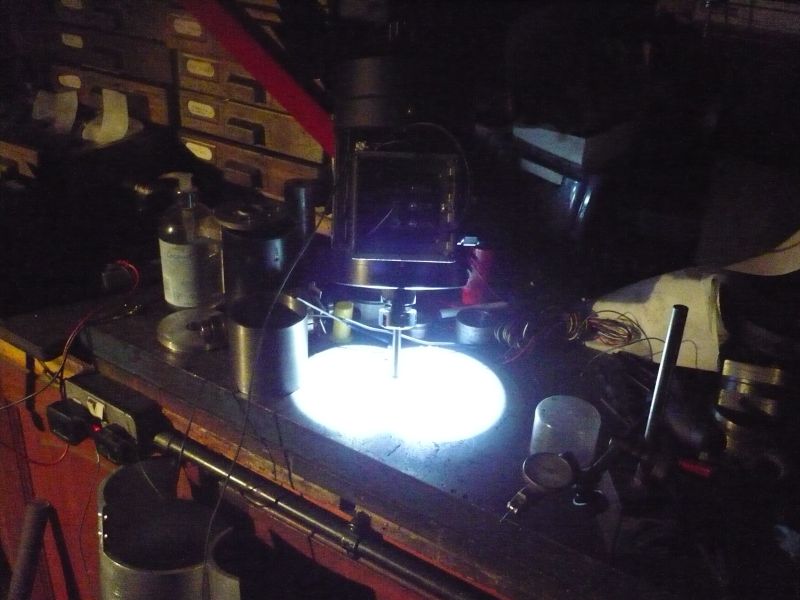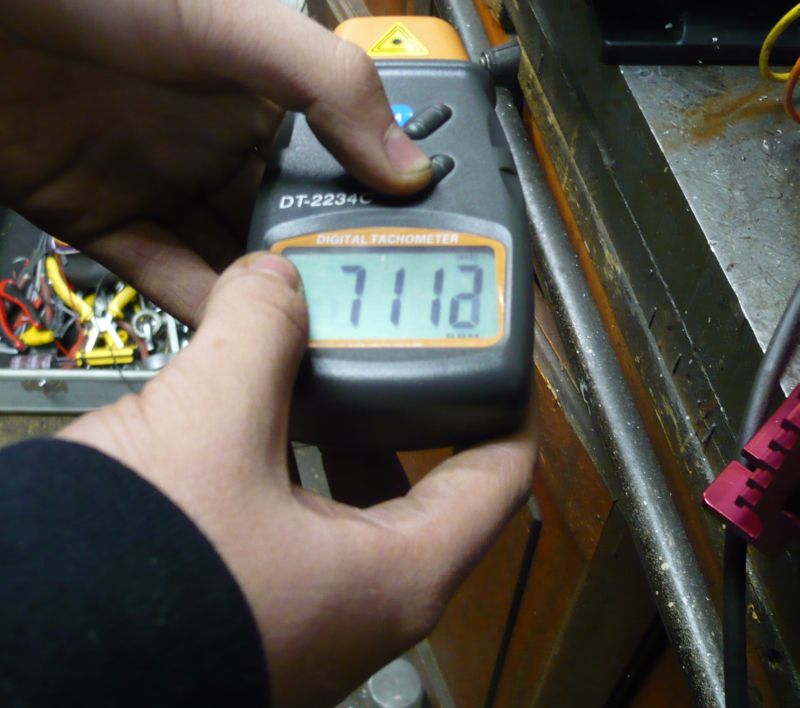Myford Super 7 Inverter Drive
| Nigel Bennett | 10/05/2014 10:24:01 |
500 forum posts 31 photos | I am thinking seriously about upgrading my Super 7 to inverter drive. It would be rather useful to increase the top speed of the lathe, and speaking to the nice man on the Transwave stand at Harrogate yesterday, he said that the only sensible way to do that was to fit a 2800rpm 3-phase motor and control the speed of that. He explained that although you see inverters showing 200Hz, it is usually physically impossible to run a motor at much more than 120% of its rated speed. A 2800rpm motor would mean a lathe top speed of 4000rpm or so - useful for drilling weeny holes and turning weeny diameters. Running the motor at 25Hz would give me the same lowest speed as now. I suppose one worrying thing is running large diameter chucks at 4000rpm - bursting one would be -erm- interesting. Hence I'd only use it for collet work at that speed. So has anybody out there tried this? If so, are there any drawbacks like increased noise? Will a 2-pole 3-phase inverter-driven motor run "lumpier" than a 4-pole 1400rpm one and thereby negate some of the advantages over 1-phase? |
| Pete | 10/05/2014 20:45:51 |
| 128 forum posts | Nigel, I've got a 3 hp 3 phase mill that's powered with a VFD. Some people seem to use that inverter term though. FWIW, You should see an almost unbelievable difference in smoothness of the motor drive, it will also be quieter, and your surfaces finishes should be much better. But, I don't agree with over driving any machine tooL much past it's factory design limits. Yes it can be done, but is it a good idea? Your bearings, spindle and pulley balance, and even the materials there built from were engineered on good quality lathes to operate at a specified maximum rpm. The higher you go with rpm then the steeper the cost curve gets as far as wear and parts replacement. They build and sell specialized very high rpm rated lathe chucks ranging from hardened steel into I'd imagine some fairly exotic light weight ultra strong aircraft grade materials for very high rpm work. But those specially balanced high rpm steel chucks alone have prices to match. Yes I know you said you were planning on using collets, but I'm trying to show how expensive something like this can become, and how quickly it can start to add up. Unless you do a great deal of very small work the costs to do this may not be worth it. And an inverter or VFD or any currently available pure electrical method will not give you full motor torque as you lower the rpms. That still requires it to be done mechanically. Whatever you do there's always a trade off that has to be done. IMO, the inverter/VFD is well worth it for the variable speeds, smoother running, better finishes, and maybe a very limited use of the higher speeds once in awhile. But if all your wanting is the high speed for small diameter work, then I think I'd be looking at something like a spindle speeder that will give you a way through gearing to increase the part rpm without increasing your main spindle speeds. And if you really want high speeds, they make very specialized air driven turbines that will do well beyond 50,000 rpm. I have to think that there's not a quality lathe manufacturer anywhere in the last 50 years that would say it's a good idea to increase the spindle rpm by 25% or more over what they designed there product to do. 4,000 RPM today is actually very slow if you look at what a lot of the newer CNC equipment is capable of. The difference is it's designed from the start to do so. And I've yet to operate any Super 7, but does yours have a proper roller bearings at both ends of the spindle, or is the front bearing the usual drip fed oil lubed solid type? Burning up a bearing and/or spindle journal could get a bit costly. I'm certainly not trying to say your idea is wrong, but there's a lot more to this than just replacing the motor on your lathe. Pete . |
| Ian P | 10/05/2014 21:06:07 |
2747 forum posts 123 photos | I would definitely fit the VFD if I were you. The motor will be MUCH smoother than any single phase motor even it his has got 4 poles. I dont see the need to fit a 2800 rpm motor, there should be no problem at running a 1440 one at twice normal speed so I think the Transwave man was being too cautious. I have a VFD on my mill and the motor is quite happy at 140Hz , the roller bearing spindle does then get warm (but never hot) but its great for small diameter cutters. The VFD on the lathe lets me turn the chuck at about 10RPM, not much torque there but good for tapping small holes or just for set up purposes. Most people that fit VFDs wonder why they did not do it sooner! Ian P |
| Russell Eberhardt | 10/05/2014 21:49:47 |
2785 forum posts 87 photos | Posted by Ian Phillips on 10/05/2014 21:06:07:
The VFD on the lathe lets me turn the chuck at about 10RPM, not much torque there but good for tapping small holes or just for set up purposes. Another big advantage is the reversing to wind the tap out again - just make sure the chuck is on tight! Russell. |
| Neil Lickfold | 10/05/2014 23:41:39 |
| 1025 forum posts 204 photos | I brought an Eric Drive VFD that is programmable for acceleration and deceleration .My motor is a 550w 1440 RPM. I have a 2 way switch where the original forward reverse switch was. Above the lathe is the control box mounted in a housing box. On there is the main on off for the VFD, and the pot with some numbers representing Hz approximately.This controls the motor speed. The control on the VFD displays the actual HZ .I have the hertz range set from 30 HZ to 60 hertz. That along with the belt changes, I do not need to go into back gear any more. I have not done it yet, but intend to connect an adjustable micro switch, so that when it gets to the switch the motor stops. I have mine ramping down and breaking, and set that to 0.2 seconds. I also have the start ramping at 0.2 seconds as well. The intention is to use it for cutting internal threads and having it stop at about the right place.Any quicker at stopping,and you risk the Chuck coming undone. When setting up the VFD there are parameters like the Max motor current etc. When set up ,it still has loads of power even at low RPM's. The only waning is that the motor can get hot if continually run at very low rpm's.In these situations, they recommend adding a small fan to keep the motor cool.So I have my min hz set at 30 as recommended by the place that sold the motor and VFD unit. My only wish is that I should have gone this way much sooner that is for sure. Neil |
| John Stevenson | 11/05/2014 00:26:05 |
5068 forum posts 3 photos | All depends on the motor. Older the motor less chance there is at running it at 200% because they get egg bound and actually slow down as you increase Hz Personally I wouldn't fit a 2 pole motor to a lathe as you will lack torque at low revs but it depends on what you want to do with it.
The very latest motors that come under type3 which is the new legislation to save power are fine as they are designed for inverter use and will go 200% , no problem.
I do these motors for special machines.
Standard 2 pole 1.1 Kw [ 1.5 HP ] 3 phase motor, off the shelf.
It then gets stripped and worked on. End result.
Shaft has been pressed out the rotor, new shaft pressed in and machined in situ in slave bearings to handle an ER32 collet then Tuftrided which is a heat treatment carried out at 400 degrees and it doesn't distort. Chuck is an integral part of the shaft.
Front housing which is very skeletal is thrown away and a new housing made from a solid 7" lump of allow to hole two angular contact bearings with preload. Two holes 23mm bored in the housing to accept two 5W CREE LED lights.
You can weld with these !!
But final proof of if it's worth it.
These run continuous for about 8 1/2 hours per day. So far only one has given any problems requireing a rebuild but that was because it was the end spindle on a 4 splindle machine and they crashed it and it threw the collet chuck out |
| Thor 🇳🇴 | 11/05/2014 06:36:14 |
1766 forum posts 46 photos | Hi Nigel, as others have said, fit a VFD/inverter to your lathe, I did that to my new lathe and am very pleased with the result. The motor is running very quiet, but noise increases when you go higher than 50Hz. John, the motor in your first photo looks exactly like the one i fitted to my lathe, except yours is bigger of course. Thor |
| WALLACE | 11/05/2014 07:49:35 |
| 304 forum posts 17 photos | How about running the original motor with a larger diameter pulley - say 50% ? Double the speed at vfd running at 'only' 75 hz ? W. |
| Nigel Bennett | 11/05/2014 13:21:05 |
500 forum posts 31 photos | Thanks, chaps, for the very valuable and thoughtful advice. It is much appreciated. I think I'll probably stick with the VFD-driven 4 pole motor, then. Your wizzo motor mods look very impressive, John!
Nigel |
Please login to post a reply.
Want the latest issue of Model Engineer or Model Engineers' Workshop? Use our magazine locator links to find your nearest stockist!
Sign up to our newsletter and get a free digital issue.
You can unsubscribe at anytime. View our privacy policy at www.mortons.co.uk/privacy
- *Oct 2023: FORUM MIGRATION TIMELINE*
05/10/2023 07:57:11 - Making ER11 collet chuck
05/10/2023 07:56:24 - What did you do today? 2023
05/10/2023 07:25:01 - Orrery
05/10/2023 06:00:41 - Wera hand-tools
05/10/2023 05:47:07 - New member
05/10/2023 04:40:11 - Problems with external pot on at1 vfd
05/10/2023 00:06:32 - Drain plug
04/10/2023 23:36:17 - digi phase converter for 10 machines.....
04/10/2023 23:13:48 - Winter Storage Of Locomotives
04/10/2023 21:02:11 - More Latest Posts...
- View All Topics
- Reeves** - Rebuilt Royal Scot by Martin Evans
by John Broughton
£300.00 - BRITANNIA 5" GAUGE James Perrier
by Jon Seabright 1
£2,500.00 - Drill Grinder - for restoration
by Nigel Graham 2
£0.00 - WARCO WM18 MILLING MACHINE
by Alex Chudley
£1,200.00 - MYFORD SUPER 7 LATHE
by Alex Chudley
£2,000.00 - More "For Sale" Ads...
- D1-3 backplate
by Michael Horley
Price Not Specified - fixed steady for a Colchester bantam mark1 800
by George Jervis
Price Not Specified - lbsc pansy
by JACK SIDEBOTHAM
Price Not Specified - Pratt Burnerd multifit chuck key.
by Tim Riome
Price Not Specified - BANDSAW BLADE WELDER
by HUGH
Price Not Specified - More "Wanted" Ads...
Do you want to contact the Model Engineer and Model Engineers' Workshop team?
You can contact us by phone, mail or email about the magazines including becoming a contributor, submitting reader's letters or making queries about articles. You can also get in touch about this website, advertising or other general issues.
Click THIS LINK for full contact details.
For subscription issues please see THIS LINK.
Model Engineer Magazine
- Percival Marshall
- M.E. History
- LittleLEC
- M.E. Clock
ME Workshop
- An Adcock
- & Shipley
- Horizontal
- Mill
Subscribe Now
- Great savings
- Delivered to your door
Pre-order your copy!
- Delivered to your doorstep!
- Free UK delivery!














 Register
Register Log-in
Log-in


